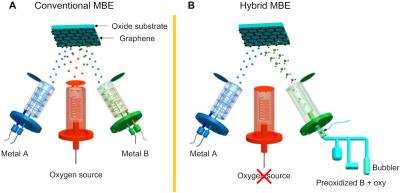Perovskite-Info weekly newsletter
Published: Tue, 01/10/23
The Perovskite-Info newsletter (January 10, 2023)
Cannot read this? View it online here
Warwick University secures USD$2.6 million grant to investigate perovskite solar cell materials
Warwick University has been granted £2.2 million (over USD$2,620,000) to investigate metal halide perovskite compounds, for use in transparent and flexible solar panels, which remain stable in space. A new Nuclear Magnetic Resonance (NMR) spectrometer will be used to understand how to increase lifespan and durability of these solar cells.
The European Research Council (ERC) has approved a five-year study which will explore the atomic-level structure of perovskite solar cell materials. This will address issues including stability and lifespan of metal halide perovskite compounds, which decrease in high humidity, strong sunlight and at elevated temperatures.
Researchers present new method for fabricating thin films of perovskite oxide semiconductors
Researchers from the University of Minnesota Twin Cities-led, University of Wisconsin–Madison and Pacific Northwest National Laboratory have developed a new method for making thin films of perovskite oxide semiconductors, a class of “smart” materials with unique properties that can change in response to stimuli like light, magnetic fields, or electric fields.
Their work could allow researchers to harness these properties and even combine them with other emerging nano-scale materials to make better devices such as sensors, smart textiles, and flexible electronics.
University of Sydney's project with SunDrive on commercializing perovskite-silicon cells secures ARENA funding
University of Sydney's Professor Anita Ho-Baillie is joining forces with Sydney-based renewable technology company SunDrive to commercialize perovskite-silicon cells, with backing from the Australian Renewable Energy Agency (ARENA) of AUD$2.78 million (over USD$1.9 million).
Other investigators on the project include Professor David McKenzie, Dr Jianghui Zheng and Dr Arafat Mahmud, who are based at the University of Sydney, and Mr Vince Allen, Mr David Hu and Professor Alison Lennon from SunDrive.
Renshine Solar announces 29.0% efficiency for all-perovskite tandem solar cell
Chinese perovskite solar technology company Renshine Solar (Suzhou) has announced 29.0% steady-state power conversion efficiency of all-perovskite tandem solar cell developed in-house. The company now expects to exceed 30% in 2023.
Japan Electrical Safety and Environment Technology Laboratories (JET) has reportedly certified the efficiency claim that was reported for a designated area of 0.04888 cm².
Researchers report on novel approach for high performance and spectrally stable deep-blue perovskite LEDs
Researchers from Yonsei University, Sungkyunkwan University and Institute for Basic Science (IBS) have proposed a rapid crystallization method based on hot-antisolvent bathing for realization of deep-blue perovskite light-emitting diodes (PeLEDs). The rapid crystallization method manipulates 2D perovskite phase evolution by controlling the crystallization kinetics for the fabrication of phase-pure 2D Ruddlesden‒Popper perovskites (2D-RPPs), enabling deep-blue-emissive perovskite LEDs.
PeLEDs are considered as promising candidates for next-generation solution-processed full-color displays. However, the external quantum efficiencies (EQEs) and operational stabilities of deep-blue (<460 nm) PeLEDs still lag far behind their red and green counterparts. 2D-RPPs have excellent optoelectronic properties—ideal for LEDs. Although 2D-RPP-based LEDs have rapidly progressed in terms of performance, it is still challenging to demonstrate blue-emissive and color-pure LEDs. The deep blue of current LED displays is usually produced by indium gallium nitride (InGaN), a costly substance. In the field of LEDs, researchers are seeking alternatives and one of them could be found in 2D-RPPs.
Swedish-Israeli research team will study the self-healing abilities of perovskite solar cells
A research collaborative project involving scientists from Sweden's Karlstad University and Israel's Ben-Gurion University of the Negev and Weizmann Institute of Science will examine how perovskite solar cells could recover and self-repair at night.
Metal halide perovskite materials have been shown to possess a self-repairing ability. One of the Israeli research teams have shown that metal halide perovskite solar cells, which degrade in sunlight, can rebuild their efficiency at night, when it’s dark. The other Israeli research team exposed single crystals of lead-based metal halide perovskites to powerful lasers, which made them lose their ability to glow. The researchers then found that the material regained its photoluminescence following some recuperation time in darkness. Even if these two observations — one in the solar cell’s thin, multicrystalline layer and the other one in single crystals — seem related, the potential relation between these two phenomena still needs to be better understood, and how it works.
The Perovskite Handbook - 2023 edition
Perovskite-Info is happy to announce the 2023 edition of The Perovskite Handbook. This book is a comprehensive guide to perovskite materials, applications and industry. Perovskites are an exciting class of materials that feature a myriad of exciting properties and are considered the future of solar cells, displays, sensors, LEDs and more. The handbook is now updated to January 2023 and lists recent developments and new companies, initiatives and research activities.
Reading this book, you'll learn all about:
- Different perovskite materials, their properties and structure
- How perovskites can be made, tuned and used
- What kinds of applications perovskites may be suitable for
- What the obstacles on the way to a perovskite revolution are
- Perovskite solar cells, their merits and challenges
- Perovskite QDs, LEDs, and other applications
- The state of the perovskite market, potential and future
The book also provides: a history of perovskite research, a guide to perovskite companies and developers, information on leading collaboration and development projects, a comprehensive list of perovskite companies, market updates and much more!
Metalgrass LTD
9 Har Tsin St.
Kfar Sava Hasharon 4430809
ISRAEL
Unsubscribe | Change Subscriber Options







